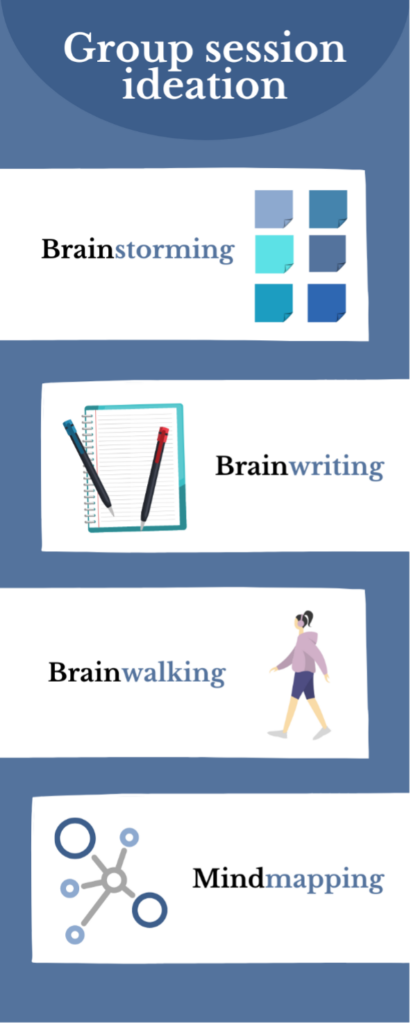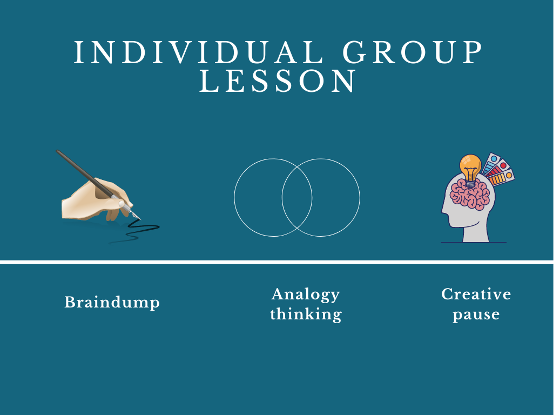The process of ideating describes the process of coming up with creative ideas to solve the problems, you are trying to tackle down. Is the third phase of Design Thinking which intends to visualize ideas based on the earlier research by empathizing and defining. Teamwork and open-minded mindset are essential in this phase allowing ¨all the ideas possible¨ to fit the user/customer needs. However, the best ideas not always come with a team work session, because sometimes people prefer to work their ideas alone. Exploring the different techniques to be conducted in a group session as well as individual will led to putting into action the ideas developed.
- Group session ideation: Based on the techniques described by Interaction Design Foundation (2021), we have highlighted the following:

Brainstorming: Within the groups, this technique allows to generate as many ideas as possible. While conducting a brainstorming session bear in mind[1]:
- Set a time: Participants should be aware that they have a time limit to complete the task.
- Start from your target group: Based on the user personas. What are the problems they are facing?
- Have an open mindset: encourage participants to bring ideas even if they are ¨wacky¨.
- Facilitate the visual ideation: By adding post it into a white board or other elements where the ideas are registered.
- Be sure there is one facilitator: To control the time and reconduct participants if they do not stay on topic.
- Construct others’ ideas: Some ideas might be similar and sometimes can be further developed, complementing the idea proposed.
Brainwriting: Similar to the previous one, with the particularity that participants write their ideas on paper, and after, they pass on their own piece paper to another . This technique helps the participants who might feel shy or inhibited. Thereby, the ideas compiled could be anonymous to facilitate the creative process of all the participants[2].
Brainwalking: Participants write a single idea on a post-it, which is placed on a wall or white board. In the second round of this technique, participants choose an idea from the board and develop the idea or add new ones[3].
Mindmapping: Mind mapping are organized into different diagrams representing actions, tasks, objectives, or concepts. The idea behind is to link different elements into a central concept to build up the ideation process[4].
- Individual session ideation: These three techniques are used for emerging ideas at the individual level.

Braindump: The technique is like brainwriting; however, participants write their ideas first individually and then share it with the team.
Analogy thinking: This technique is based on the research of existing products, companies, or ideas to translate them to your own developing context[1].
Creative pauses: While feeling stuck with ideas, creative pauses are necessary to bring further perspectives into the design process. Sometimes, ideas do not come with justification enough to go ahead with the testing phase. Nevertheless, it is important to remember that Design Thinking is not a linear process and after the testing session some of the ideas drafted can emerge for further implementation.
These techniques are necessarily practical, when using them try to synthesize the ideas that have appeared for concretized the desirable actions toward the next phase: Prototyping.
[1] https://www.boardofinnovation.com/staff_picks/our-favorite-ideation-tools/
[1] https://www.mindmapping.com/mind-map
[2] https://xn--designthinkingespaa-d4b.com/brainwriting
[3] https://innovationenglish.sites.ku.dk/metode/brainwalking/